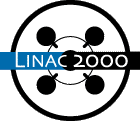
P.N. OSTROUMOV, J.A. NOLEN, K.W. SHEPARD (ANL)
There is demand for the construction of a medium-energy ion linear accelerator based on superconducting RF (SRF) technology and capable of producing several hundreds kilowatts CW for beams from protons to uranium. At present, however, the beam power available for the heavier ions would be limited by ion source capabilities. To overcome this limit, we have studied the possibility of accelerating multiple-charge-state beams through a linac. We show that such operation is made feasible by the large transverse and longitudinal acceptance which can be obtained in a linac using superconducting cavities. Multi-charge-state operation provides not only a substantial increase in beam current, but also enables the use of two strippers, reducing the size of linac required. Since the superconducting linac operates in CW mode, space charge effects are essentially eliminated except in the ECR-RFQ region. Therefore the controllable effective emittance growth due to the multi-charge beam acceleration can be allowed. Taking uranium as an example, this paper follows the beam dynamics of a multiple charge state beam through each of the three parts of a linac defined and separated by the two stripping targets. In particular, we show the feasibility of the accelerating a two-charge state uranium beam in the prestripper section (below 12 MeV/u). Between the first to the second stripper (85 MeV/u) the beam has an average charge state 75. In this region 5 charge states can be accelerated simultaneously. After the second stripper 99% of the beam in four charge states neighboring charge state 90, all of which can be accelerated to the end of linac. The behavior of this multiple-charge state beam has been studied both by analytical and numerical methods. The effects of various factors, such as beam mismatch, misalignments, accelerating field errors and others, on the effective emittance growth of multiple-charge beam are discussed. Our studies show that by using this technique, 120 kW of uranium beam at 400 MeV/u can be achieved with present-day ECR ion source performance.
* Work supported by the U. S. Department of Energy under contract W-31-109-ENG-38
Comments or Questions to
linac2000@slac.stanford.edu